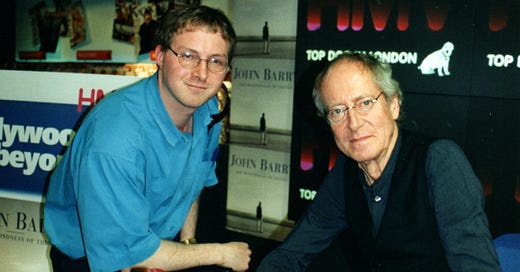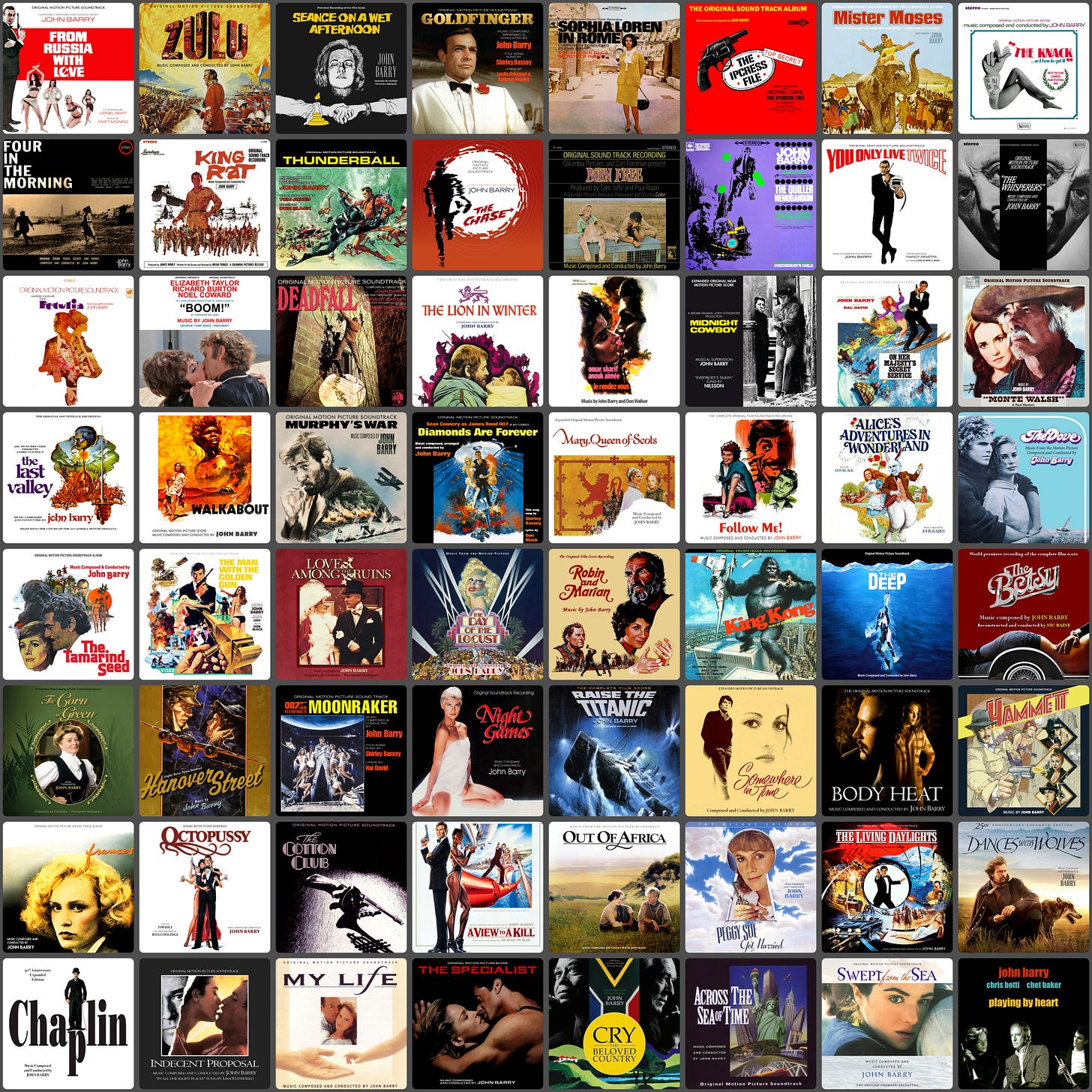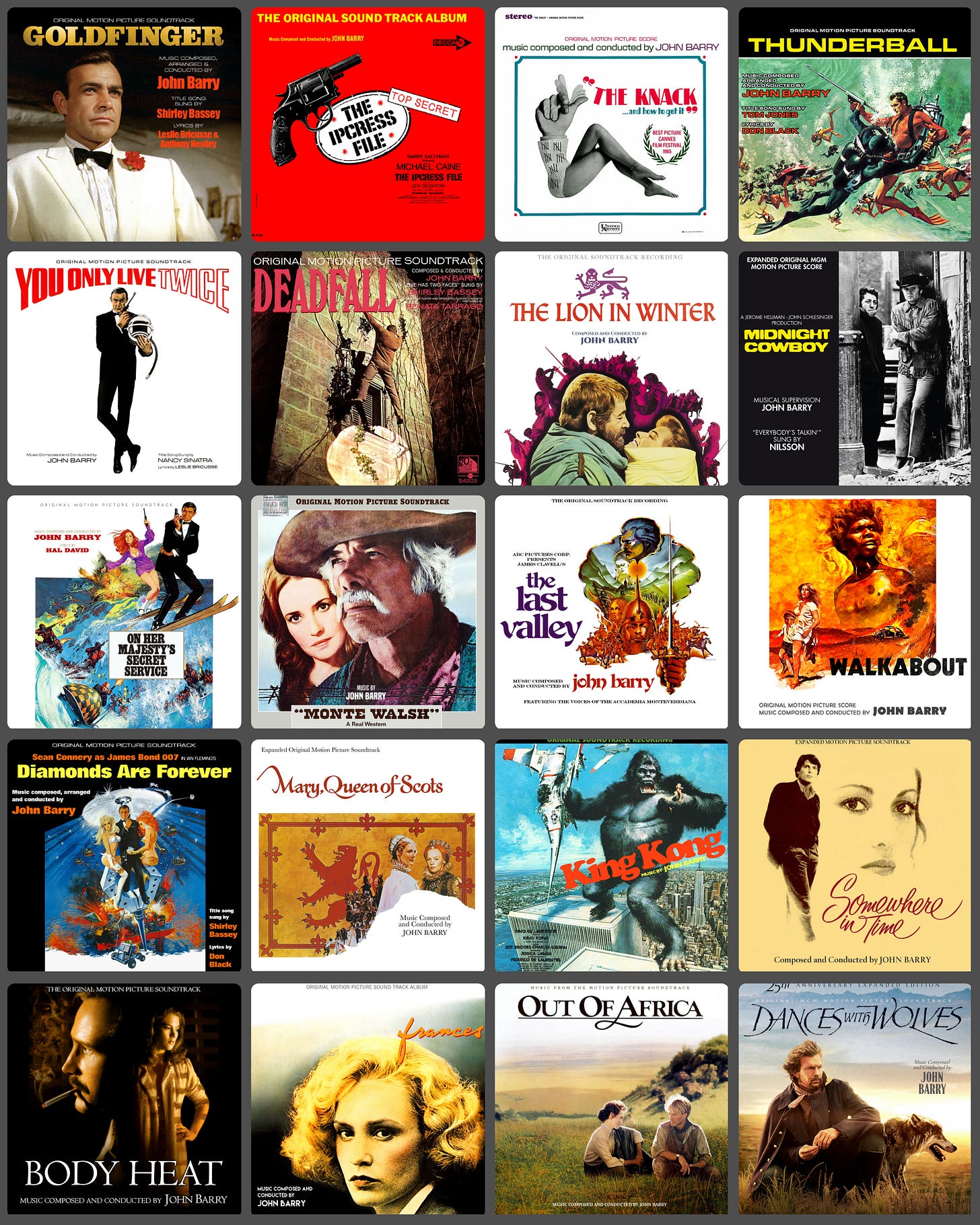Attempting a Crème de la Crème Collage for the Work of John Barry
Visualising a great body of film music.
To construct an effective visual representation of any artist’s body of work, reduction is necessary.
For one thing, no matter how strong that body of work is, if the artist was by any standard prolific, their total body of work will be too much for the newcomer to consume. It will lose them.
For another, not everything can be the artist’s top notch work. Even Alfred Hitchcock, possibly the greatest cause célèbre film director of all time, had relatively stronger and weaker works, even if the weakest work is still stronger than a lot of weaker directors’ best.
On the other hand, if we wish to demonstrate what a rich body of work it is, we also need to express the impressive breadth.
It’s no secret that John Barry is the film score composer whose work I love most. The qualities and personality of his work resonate with me very deeply. I’m not saying he is the greatest technical master of the compositional or orchestration arts. As he said himself during his lifetime, he wasn’t classically schooled, and if he had to take a theory exam, he’d probably flunk it.
There are plenty of composers in film who demonstrate a wider and more bravura range of compositional technique, but I don’t love their music as much. Music is first and foremost an intiuitive art of channeling motion and emotion into a felt experience. John Barry had that intuition, and he had it especially strongly in the context of film. He also had excellent taste, both musically, and in how we interpreted film.
My challenge to myself was to reduce John Barry’s considerable filmography into his strongest work, whilst also demonstrating what a large and broad body of work it is.
I decided to do this in three waves of reduction.
The first wave of reduction was to reduce the catalogue to a 10x8 panel of 80 titles—already a substantial reduction on the circa 120 films he worked on.
Some are custom covers, obviously.
The First and Broadest Reduction
My first reduction is to focus on titles that are substantially represented on disc. I'd love to have included titles like They Might Be Giants (1971), Eleanor and Franklin (1976), The Gathering (1977), Willa (1979), Touched by Love (1980), and Svengali (1983), but they don't have discs. Yes, They Might Be Giants and Eleanor and Franklin have single tracks on compilation discs, but I don’t count that as the score being substantially available on disc. As a short score, A Doll’s House (1973) is at least complete and headlined on a disc from Quartet records.
What a body of work, right?
I didn’t include The Glass Menagerie (1973) because I didn’t want too many short scores pushing out more substantial scores, although that score, like A Doll’s House, is utterly sublime.
I’m okay with omitting Beat Girl (1959), John Barry’s first film score, because whilst I quite like it and it’s a significant event in the artist’s journey, as a first score always is, it’s not one I recommend to get people into John Barry.
I’m equally comfortable with omitting Mercury Rising (1998) and The Scarlet Letter (1994), because whilst they are still very fine film scores, at least by film score averages, they are easier to identify as lesser works, relatively speaking, within John Barry’s body of work.
Bells, also known as Murder By Phone (1982) isn’t without interest, and I would surely purchase it if it came out on disc—this is John Barry we’re talking about, after all! It is, however, easier to identify this title as a lesser work and non-contender for the collage. Besides, it doesn’t have a disc.
My Sister’s Keeper (1985), if it had a disc release, would have been in with more a chance. Whilst still a relatively lesser score among John Barry’s body of work, I think that one is actually quite interesting and is one of my high hopes for a future disc release.
I would have liked to have included Man in the Middle (1964), The Golden Seal (1983), and Enigma (2001) in this collage, but I wanted to keep this a reduced, selective list. Since Man in the Middle and The Golden Seal are only partially by John Barry, albeit his contributions are excellent, I reluctantly cut them, and Enigma, much as I think it is also a fine score, just couldn’t quite displace anything else I’d picked. Not for me.
There are one or two relatively weaker scores that crept past the purple entry rope, I grant you. Masquerade (1988) and Game of Death (1978) are examples, but even if they’re relatively lesser to John Barry’s greatest works, they are still strong film scores by absolute standards and have a firm body of fans. They are popular among the film score community, have strong themes at their core, and I don’t think they lessen the message of the collage: that this is a large, strong, impressive body of work.
Titles like The White Buffalo (1977) and Jagged Edge (1985) might not be universally loved, but, personally, I find them both to be very interesting and effective scores. They are somewhat striking for being somewhat unusual and different. Both are quite under-rated, in my opinion.
The Second Reduction
To reduce the collage to an even more intense, even more crème de la crème retrospective of only 64 titles (8x8), the titles I’d remove are: The Wrong Box (1966), A Doll’s House, only because it’s so short, The White Buffalo, First Love (1977), Game of Death, Star Crash (1979), The Black Hole (1979), only because it divides fans, Inside Moves (1980), again, only because it’s short, Legend of the Lone Ranger (1981), High Road to China (1983), Mike’s Murder (1984), Until September (1984), Jagged Edge, The Golden Child (1985), Masquerade, and Ruby Cairo (1992). It’s not that they aren’t good. It’s that the competition to get into the top 64 is tough.
It’s getting more intense, right?
The Third Reduction
I feel happy with the 8x8. It already feels like a highly reduced list that showcases John Barry’s best work whilst also showing its breadth. It felt like cutting off toes to achieve that. Nevertheless, 64 items is still too much to introduce the artist to a new and potentially appreciating audience.
My next challenge is a reduction to 20.
That requires harshness, but arrives at a super-intense list. The very, very best. La crème de la crème de la crème!
It wasn’t easy. Including Thunderball (1965) felt like James Bond films might be over-emphasised and I nearly swapped it for Petulia (1968).
I struggled to pick between King Kong (1976), The Deep (1977), and Night Games (1979) for a place in this list. I think that both The Deep and Night Games are remarkable works that are interesting, engaging, and under-rated, but in the end, I felt King Kong was the strongest of the three and the most justifiable for a top 20 position. Some may feel I should have leaned more into the romantic work with something wistful like Love Among The Ruins (1975). I wouldn’t necessarily argue, but it’s tough at this level.
Part of me feels like The Day of the Locust (1975) should really be here, which is another criminally under-rated work, but there just isn’t enough space for everything, even when titles like this one feel essential.
Of course, this will not be to everyone’s taste. Do you remember me mentioning that The Black Hole divides fans? I know fans who think it’s John Barry’s greatest work. They will be angry that it’s not in the final stage. The thing is, I also know fans who think it’s just about the worst thing he ever did. Me, I love it, but its divisiveness is why it got eliminated fairly early on.
In a similar vein, I also know some fans who find Dances With Wolves (1990) to be a bloated work, while others consider that one to be his singularly greatest work. I’m standing by that one. It has earned its place through it’s combined, enduring critical and commercial success, and I love it.
Don’t ask me to reduce even more.
The Greatest Works
Goldfinger (1964)
The Ipcress File (1965)
The Knack and How to Get It (1965)
Thunderball (1965)
You Only Live Twice (1967)
Deadfall (1968)
The Lion In Winter (1968)
Midnight Cowboy (1969)
On Her Majesty’s Secret Service (1969)
Monte Walsh (1970)
The Last Valley (1970)
Walkabout (1971)
Diamonds Are Forever (1971)
Mary Queen of Scots (1971)
King Kong (1976)
Somewhere In Time (1980)
Body Heat (1982)
Frances (1982)
Out of Africa (1985)
Dances With Wolves (1990)
There’s a definite concentration between 1964 and 1971, isn’t there!
The Works to Expand to 64
From Russia With Love (1963)
Zulu (1964)
Seance on a Wet Afternoon (1964)
Sophia Loren In Rome (1964)
Mister Moses (1965)
Four In The Morning (1965)
King Rat (1965)
The Chase (1966)
Born Free (1966)
The Quiller Memorandum (1966)
The Whisperers (1967)
Petulia (1968)
Boom! (1968)
The Appointment (1969)
Murphy’s War (1971)
Follow Me (1972)
Alice’s Adventures in Wonderland (1972)
The Dove (1974)
The Tamarind Seed (1974)
The Man with the Golden Gun (1974)
Love Among The Ruins (1975)
The Day of the Locust (1975)
Robin and Marian (1976)
King Kong (1976)
The Deep (1977)
The Betsy (1978)
The Corn is Green (1979)
Hanover Street (1979)
Moonraker (1979)
Night Games (1979)
Raise The Titanic (1980)
Hammett (1982)
Octopussy (1983)
The Cotton Club (1984)
A View to a Kill (1985)
Peggy Sue Got Married (1987)
The Living Daylights (1987)
Chaplin (1992)
Indecent Proposal (1993)
My Life (1993)
The Specialist (1994)
Cry the Beloved Country (1995)
Across the Sea of Time (1995)
Swept from the Sea (1997)
Playing by Heart (1998)
The Works to Expand to 80
The Wrong Box (1966)
A Doll’s House (1973)
The White Buffalo (1977)
First Love (1977)
Game of Death (1978)
Star Crash (1979)
The Black Hole (1979)
Inside Moves (1980)
Legend of the Lone Ranger (1981)
High Road to China (1983)
Mike’s Murder (1984)
Until September (1984)
Jagged Edge (1985)
The Golden Child (1985)
Masquerade (1988)
Ruby Cairo (1992)
The Wrap-Up
I’ve shared my thinking. What’s yours? Let me know!







